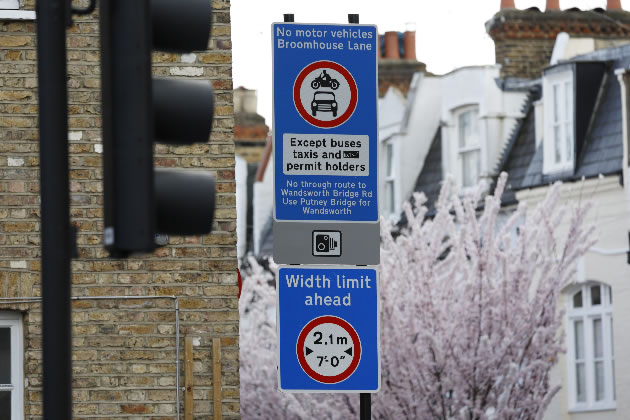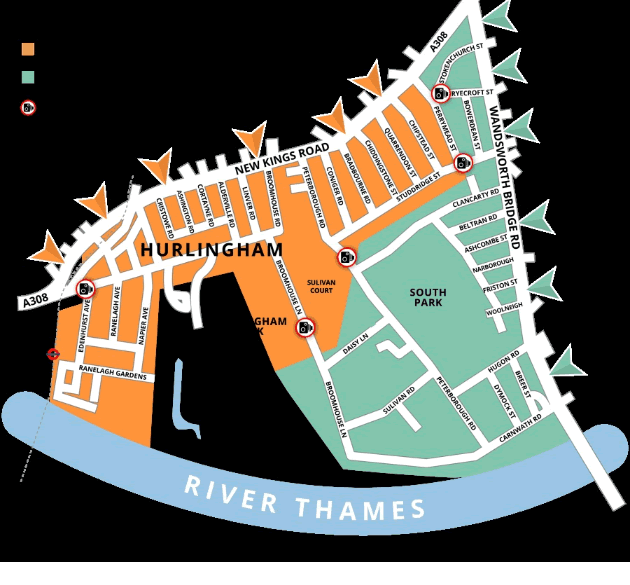Council Reveals How Clean Air Fines are Being Spent
Cameras are funding projects including new parking bays and cycle routes

The Clean Air Neighbourhood trial west of Wandsworth Bridge was implemented in February 2023. Picture: Facundo
April 25, 2024
Hammersmith & Fulham Council is spending millions secured via clean air fines on schemes, from new parking bays to a cycle route. The borough made almost £12 million from its Clean Air Neighbourhoods (CAN) in south Fulham last year, a portion of which went on overhead and maintenance costs.
The council has now revealed, however, that more than £3m has either been spent on, or earmarked for, a range of healthy streets and environmental projects, with other, larger schemes in the pipeline. A spokesperson for the council said the initiatives are designed ‘to make Hammersmith and Fulham the best place to live, shop and work’. However, the council says some of the cash is being generated from rich drivers who just ignore the restrictions and happily pay.
While the borough has been covered by ULEZ since 2021, the council also runs two CANs in south Fulham, one either side of Wandsworth Bridge Road, in a bid to further cut emissions. The first, to its east, was set up in July 2020 and made permanent the following December. The scheme to the west was implemented from February 2023, with the council’s cabinet making it permanent last month.
Designed to deter out-of-borough drivers from rat-running through residential side streets and bring pollution levels down, the CANs involve cameras being installed at key locations, with the council issuing penalty charges issued to those caught in the zones. Residents with cars registered in the borough, black cabs, carers, business visitors and others with exemptions do not have to pay the fine.
The scheme has proven controversial since the first CAN was implemented. Advocates have praised the impact on the side-streets, with the council claiming the number of drivers from outside Hammersmith and Fulham has dropped by 78 per cent since the trial to the west began. Others, however, say the CANs simply push traffic onto other roads, causing congestion on main thoroughfares such as New Kings Road and Wandsworth Bridge Road.
Council data shows, in 2023, the two CANs pulled in £11.8m in fines – £7.8m from the western scheme, and £4m from the eastern. The council, however, predicts the more-recently established western CAN will reduce to around £2.6m in 2024, due to drivers becoming accustomed to the scheme. A spokesperson said some wealthy drivers have begun to treat the £65 fine as a toll, and have even asked if they can set up a direct debit.
The council has now revealed the projects being funded by more than £3m of the income received via fines from the two CANs. These are:
- A major street scene makeover of Wandsworth Bridge Road and New King’s Road including new bike racks, high quality seating, signage, hanging baskets, planters and mini-parklets
- A new safe ‘quietway’ cycle route, working with Transport for London (TfL), connecting Putney Bridge to Fulham Broadway and Imperial Wharf. New shopper parking bays for Wandsworth Bridge Road and New Kings Road
- Improved safety at pedestrian crossings, with raised crossings, and new zebra crossings at existing island locations
- Improved and side street junctions, removing block paving, shortening the distance to cross and introducing sustainable drainage planting
- Improved visibility of retail areas, with new high-impact road surface, planters, stylised street furniture, architectural lighting and banners
- 18 new trees on Wandsworth Bridge Road and over 100 on streets to the east
- A new wildflower verge on the New King’s Road, adjacent to Eelbrook Common acting as a buffer between the road and pavement and protecting against flooding
- New cycle hangars in Settrington Road, Dymock Street, Edenvale Street, Friston Street, Rosemary Road, Woolneigh Street, Cranbury Road, Snowbury Road
- Footway and parking improvements on New King’s Road between Wandsworth Bridge Road and Bagleys Lane

A map showing the South Fulham (West) CAN area. Picture: Hammersmith and Fulham Council
A council spokesperson added there are longer-term, and so more expensive, schemes also being worked on, though these will require more scoping and planning, with input from TfL. They include a redesign of Wandsworth Bridge junction with Townmead Road and Carnwath Road, to introduce signalised pedestrian crossings, and further works to Wandsworth Bridge Road, such as mini parklets and anti-flooding measures.
The spokesperson said, “15,000 fewer cars a day are using the residential side streets of south Fulham as commuter cut-throughs, while 1.4 tonnes of deadly nitrogen oxide (NOx) and two tonnes of climate-damaging carbon emissions have been removed from the air.
“Since the recent clean air trial began, fines have tumbled by almost 80 per cent as predicted and pollution from congestion has become a thing of the past in residential streets, which are now quieter, cleaner and safer.
“Any surplus from the fines goes into our ambitious programme of hundreds more trees, new safe cycle routes, better flood drainage and green landscaping, and encouraging play streets and café culture – all to make Hammersmith and Fulham the best place to live, shop and work.”
Ben Lynch - Local Democracy Reporter